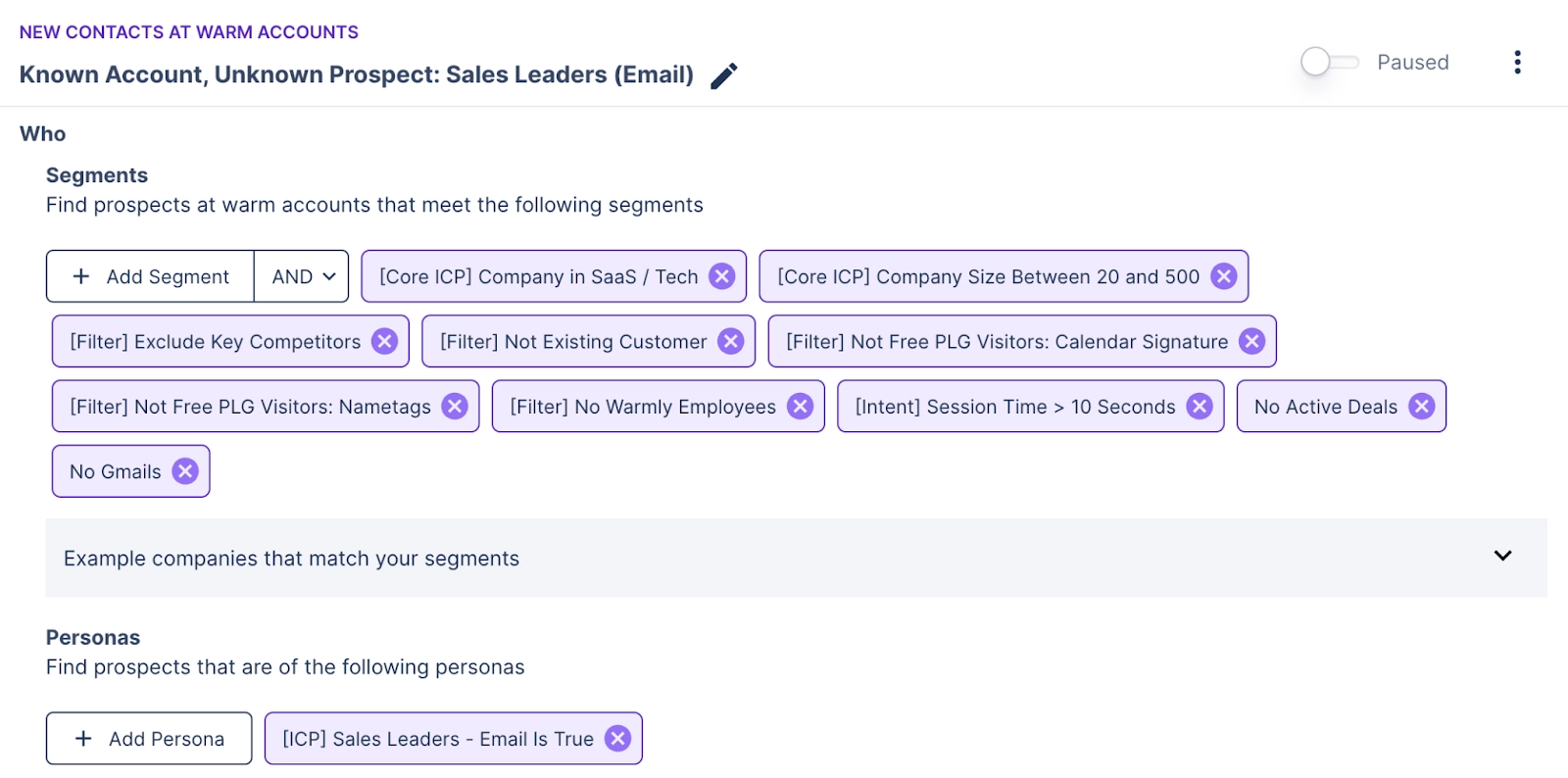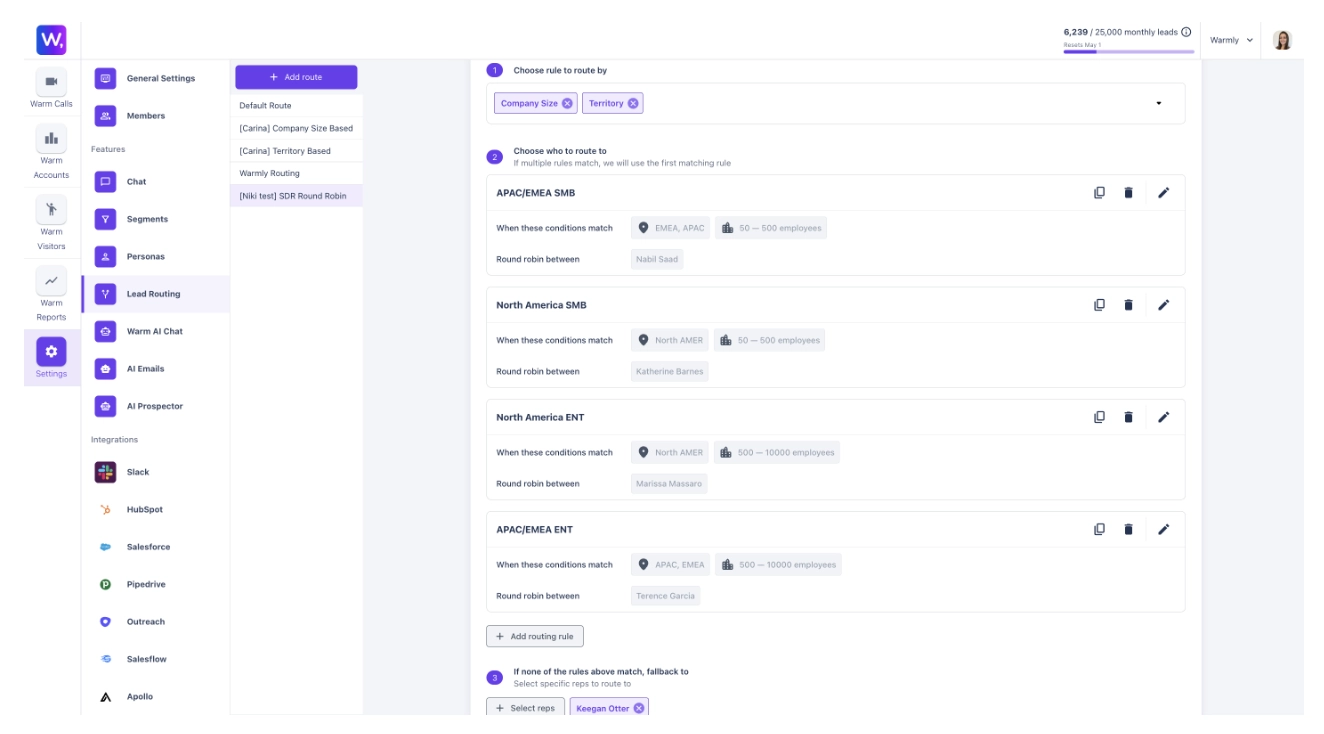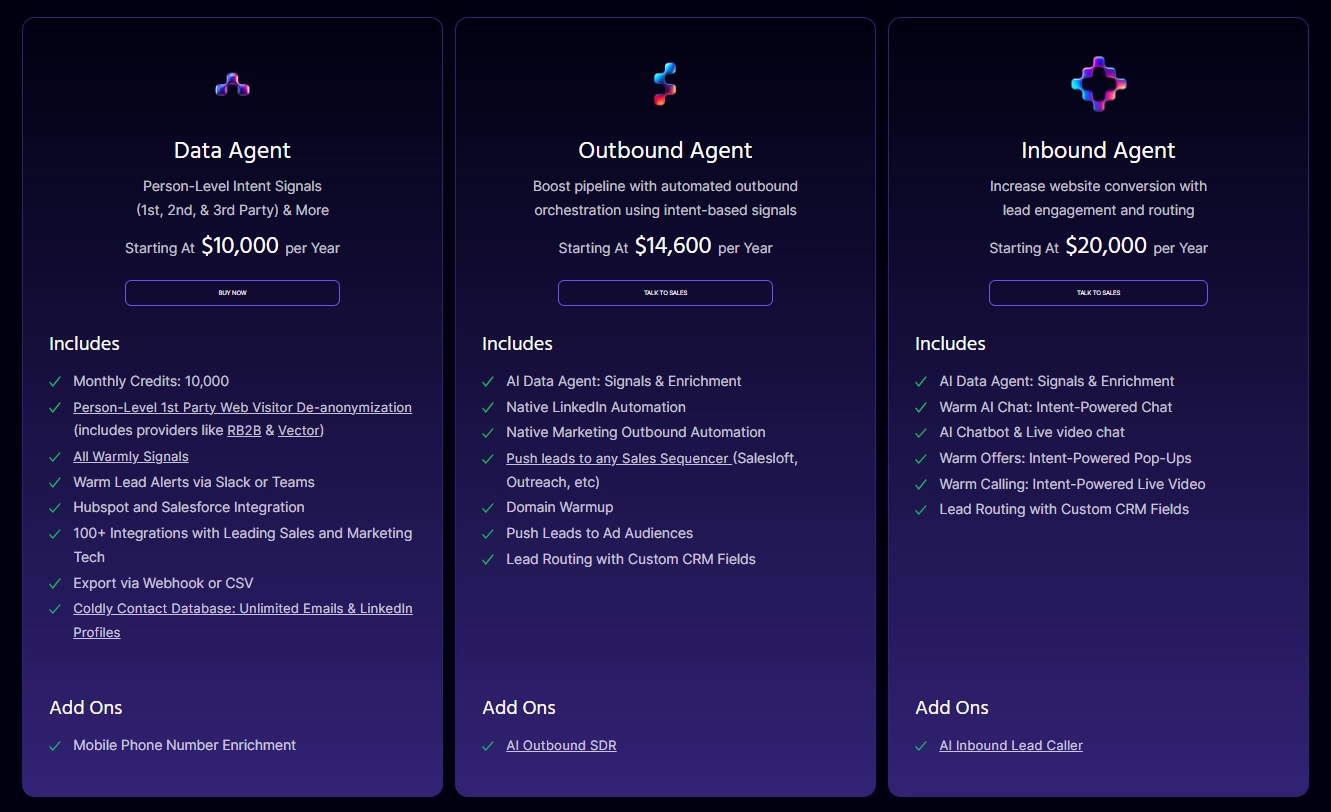
ZoomInfo vs Salesgenie vs Warmly: Which One Is the Best? [2025]
Are you evaluating which is the better tool between ZoomInfo vs Salesgenie for your sales team?
Read to find out as I’ll explore both tools’ features and key strengths, customer sentiments, and pricing structures, giving you all you need to make an informed decision.
However, since neither ZoomInfo nor Salesgenie is suitable for every user type, I’ll introduce a third option—Warmly—to ensure everyone finds their best fit.
Let’s dive straight in!
ZoomInfo vs Salesgenie vs Warmly
I’ll begin by outlining Warmly, as it’s more flexible than the other two platforms in terms of use cases and functionality.
Warmly Features
Warmly is a signal-based revenue orchestration platform, not a typical lead generation solution.
As such, it has several features that make it a strong alternative to both ZoomInfo and Salesgenie, including the following:
1. Captures the hottest leads on your website in real-time
One of Warmly’s core features is its website traffic deanonymization.
The platform reveals the companies and individual accounts visiting your website and proceeds to enrich each with:
- B2B data, including essential contact data, firmographic, technographic, demographic, CRM, and other vital data.
- First-party intent data, including pages they visited, time spent on each page, recurring visits, etc..
- Third-party intent data, including keyword searches relevant to your product, visits to competitors’ websites, job change intent, etc.

As a result, your sales reps will be provided with a high-quality lead list from the get-go, as the combination of B2B and intent data delivers a clear and complete picture of:
- Who your leads are and how you can contact them.
- Which of these shows the highest buyer intent right now based on the intent data insights Warmly uncovered.
This way, reps can focus on the companies and stakeholders that are most likely to buy right now and leverage the data they have on them to tailor their strategies and optimize them for success.
2. Live lead engagement
The whole point of lead generation is to find quality leads qualified for conversion.
However, if too much time passes between capturing leads interested in your product and engaging with them, you can miss a lot of low-hanging fruit.
Warmly enables your reps to pounce on leads while they’re hot, that is, while they’re still on your website and their interest in your product is at its peak via its live chat or video call options.
In Warmly’s dashboard, reps can monitor leads’ web sessions in real-time.
Once they detect a high-intent lead, they can contact them through text or video chat, as nothing can replace good, old, face-to-face interaction when it comes to successfully closing deals.

Learn how Behavioral Signals sourced $7M in its pipeline by leveraging Warmly’s live engagement features.
3. Signal-based sales orchestration
In addition to helping reps identify the hottest leads, Warmly leverages intent signals to automate various sales workflows.
There are three options your GTM team can use to orchestrate sales operations:
Orchestrator puts outreach on autopilot. It automatically adds leads exhibiting high-intent behavior and/or matching your ICP to personalized email and LinkedIn sequences, ensuring that each warm lead will be contacted while still warm.

AI Chat automatically engages leads, answers their questions, qualifies them, books meetings, etc., leveraging AI to make each conversation contextual and personalized (your reps can also take over at any point).

Real-time alerts take care of lead routing. When a high-value lead matching your ICP lands on your website, your reps will immediately be notified via Slack, significantly reducing the time to lead and improving leads’ experience with your brand.

This way, reps will have more time to focus on closing deals, and you’ll ensure that all quality leads are adequately taken care of at the same time.
4. Prospecting database
Warmly also has a static B2B database - Coldly - that further improves prospecting efforts and enables automatic CRM enrichment with accurate, daily-refreshed data.

Coldly holds data on 250M+ companies and contacts, which you can leverage to make targeted lead lists thanks to its advanced filtering options.
The database comes with a nifty browser extension as well, enabling you to run 1-click lead generation anywhere on the web.
ZoomInfo Features
ZoomInfo is an end-to-end sales platform with a wide range of features built for enterprises that need to manage all their sales and marketing operations from a single platform.
When it comes to running lead generation and prospecting, several of ZoomInfo’s features stand out the most, including:
1. Extensive B2B database
ZoomInfo is best known for its massive B2B prospecting database, which holds data on 260M+ individual profiles and 100M+ company profiles, as well as over 135M verified mobile phone numbers.

Its database comes with lead enrichment options, providing more than 300 attributes to help you build highly targeted and detailed lead lists.
2. Website visitor tracking
ZoomInfo helps you run website-based lead generation by revealing companies visiting your website.

However, unlike Warmly, ZoomInfo cannot identify individual visitors.
Of course, you can use ZoomInfo’s database to narrow down your search and single out actual key stakeholders and buying committees, but it will take more time and might not be as accurate as getting a clear view of individual website visitors from the get-go.
3. Predictive lead generation
ZoomInfo uses AI-powered predictive analytics to help you create more precise ICPs and pinpoint accounts that match it in its rich database.

This way, you can proactively contact accounts that are most likely to be interested in your product based on your historical and real-time data on won and lost deals, high-performing accounts, ICP attributes, etc.
Salesgenie Features
Salesgenie is a comprehensive lead-generation platform that combines software tools with various marketing services to help you achieve the best results.
It’s a good choice for building highly targeted lead lists and automating email outreach thanks to a few key features:
1. Vast database of leads across industries
Salesgenie has a large prospecting database with over 16.5 million verified businesses and 275 million individual consumers.

To ensure that the data is accurate and fresh, Salesgenie runs weekly updates on 300+ various attributes, including email and phone.
However, its key selling point is that the database can easily be segmented based on various verticals, helping users of all types find exactly the kind of leads they need.
There’s also a satisfaction guarantee—if any of the data you get is inaccurate or outdated, you’ll receive a refund.
2. Mobile app
Unlike most similar platforms, Salesgenie has a mobile app that enables users to run optimized lead generation campaigns, build lead lists, and manage them on the fly.

The app includes several nifty options, such as:
- Search Near Me - Search your current location to find all the nearest businesses or consumers
- Manage Leads - Maintain up-to-date contacts, set lead status or tags, and create follow-ups
- Gain Insights - Research your prospect and identify the decision maker beforehand
- Map Your Leads - The Salesgenie App uses your location to provide driving directions to your next meeting
Add Custom Contacts: The lead manager allows you to create and organize custom contacts
3. Email campaign builder
Salesgenie lets you build email campaigns from top to bottom and schedule their sending.
The platform offers various templates and professional help crafting email copy and design, as well as in-built mobile optimization.

However, you should note that its email automation capabilities cannot really compare to Warmly’s or ZoomInfo’s as they are much more basic and require more manual work.
ZoomInfo vs Salesgenie vs Warmly - Integrations
When buying a lead generation platform, it is essential to check how well it works with other relevant sales, GTM, CRM, and similar tools.
That’s why I’ll quickly go over the integrations you’ll get with each of these solutions.
Warmly Integrations
Currently, Warmly integrates with a wide range of platforms, including:
- OpenAI.
- Slack.
- Apollo.
- Outreach.
- Demandbase.
- 6Sense.
- Clearbit.
- People Data Labs.
- And more.

However, in addition to deep integrations with several lead intelligence and sales tools, Warmly also provides a Warm Bundle—partner discounts for over 25 sales, marketing, and GTM tools.

This way, you can access many relevant lead intelligence and sales automation tools and combine them with Warmly’s capabilities at a fraction of the usual price.
ZoomInfo Integrations
ZoomInfo integrates with 70+ apps from different categories, such as CRMs, sales engagement platforms, automation tools, etc.

Its notable integrations include Pipedrive, Salesloft, Zapier, JazzHR, Greenhouse, and more.
Salesgenie Integrations
Unlike Warmly and ZoomInfo, Salesgenie doesn’t have any native integrations.
Instead, it has partnerships with just four sales and data management platforms:
- Blitz.
- Openprise.
- Call Logic.
- QuoteBurst.

ZoomInfo vs Salesgenie vs Warmly - Pricing
Everyone aims to get good value for their money, so let’s examine what each platform offers and how much it charges users.
Warmly Pricing
Warmly has a free forever plan with which you can:
- Identify up to 500 people and companies visiting your website per month.
- Pinpoint leads that fit your ICP.
- Set up automated lead routing via Slack notifications.
To access more detailed intent data and orchestration features, you can choose from three plans:

Startup: Starting from $700/mo, includes:
- 3 seats.
- Up to 10,000 identified website visitors.
- Starts at 1,000 Orchestrator credits.
- Live Chat, Video Calls & 5,000/mo AI Chat credits.
- Warm Bundle Tech Partners discounts.
Business: From $1,440 to $1,740/mo, depending on the number of identified visitors (10,001-100,000), includes:
- Everything in Startup.
- 10 seats (+$25/month per additional seat).
- 1 Free LinkedIn Sequencing Seat.
- Dedicated Customer Success Manager.
- Automated Bombora third-party intent signals (+$4,000 Add-On).
Enterprise: Custom pricing, includes:
- Everything in Business.
- 20 seats (+$25/month per additional seat).
- 100,001+ identified visitors per month.
- Starts at 50,000/mo Orchestrator credits.
- Advanced Al personalization.
- Custom RevOps buildouts.
- Custom integrations.
- Multiple domains.
- Automated Bombora third-party intent signals are included in the price.
Note: All plans are billed annually.
ZoomInfo Pricing
Unfortunately, ZoomInfo doesn’t disclose actual prices.
According to its website, ZoomInfo has three plans - for Sales, Talent, and Marketing teams - all of which have custom pricing and lock you into 12-month contracts.

These packages differ primarily in the integrations and features they include, as each is geared toward a specific type of user.
You’ll have to contact ZoomInfo’s team for a quote.
What I can tell you from the get-go, however, is that the price will depend on several factors:
- Features and functionality.
- Number of licenses.
- Credit usage.
- The type of intelligence you need (more robust info such as technographic attributes and org charts will create additional costs).
- Add-ons you want included (e.g., Streaming Intent for revealing buying intent in real-time).
- The integrations you need.
Vendr’s data shows that ZoomInfo's average contract value is over $80,000, but it can quickly soar to six figures for larger companies with more complex needs.
Salesgenie pricing
Salesgenie has a 3-day free trial that gives you access to the platform’s lowest pricing tier features.
Once it expires, you can subscribe to one of three plans:
- Individual: Starting from $149/mo, includes 1 user, unlimited lead list building, free customer profile analysis, lead management, etc.
- Team: Starting from $299/mo, includes 5 users and everything in Individual, plus performance tracking.
- Custom: Custom price, everything in Team, plus engagement and data solutions.

Each package includes 500 monthly export credits. Once you spend them, you’ll have to buy more.
Therefore, the final price of Salesgenie will depend on several factors, including credits, the number of users, and the databases and tools you want access to.
Note: All plans are annual.
ZoomInfo vs Salesgenie vs Warmly - What are the users saying
Finally, to understand how each platform performs, let’s explore several user reviews for Warmly, ZoomInfo, and Salesgenie.
Warmly Reviews
TL;DR: Warmly gets the job done for users across industries. It’s easy to use, has robust integrations, has a generous free plan, and, most importantly, delivers as promised - a steady pipeline of warm leads.

There are many options out there, but we chose Warmly for many different reasons.
1. They got me to take a meeting using their product. I visited their website from a cold email from Max, and he was positively relentless afterwards with his contact.
2. They sold me on the future of the product. They have kept up their promises and updated their product in impressive time. For instance, we now use their Warm AI Chat to take contextual info on and chat with anyone visiting our website.
3. Plug and play. With many other solutions, there were professional services and 45-day onboarding plans. We were good to go on Day 1.
4. A legit Hubspot integration! The data they send back to our CRM is clean and happens seamlessly.
5. Amazing Customer Support. At this point, Warmly is an extension of Kandji, and I consider maximus greenwald and Ryan Beyer colleagues from another company. - Allan Ramsay, Revenue Programs VP at Kandji

Integration truly only took minutes to do, with minimal knowledge of website systems required.
A generous free tier means you can get started quickly to see if it works for your business.
BIG PLUS: Warmly sales team was informative and did not pressure us at all; truly felt like they wanted to do what was right for our business, not just to get us to upgrade. - G2 Review

We can easily identify and find the people visiting the website and target the right accounts. - G2 Review
ZoomInfo Reviews
TL;DR: ZoomInfo is a powerful sales tool with a comprehensive database and a vast range of features. However, it is cost-prohibitive for smaller businesses, has limited data coverage regarding niche industries and smaller markets, and its data isn’t updated as often as it should.

It is expensive for larger small businesses looking to grow, especially in rural markets. It is a product that is "over our head" when it comes to need. I just don't think our market needed for it at this price point. But I believe it would be beneficial for others in larger markets. Take that into consideration when making your choice. The product itself is great. I just don't think it's the right fit for everyone. - G2 Review.

Some downsides to ZoomInfo Sales include its relatively high cost, which may be prohibitive for smaller businesses. Additionally, the interface can be complex for new users, requiring a learning curve to fully utilize all features. Finally, despite its rich data, there can be limitations in coverage for niche industries or smaller markets. - G2 Review

The only thing I can complain about is how often the data is updated. Sometimes I find prospects have left the company I am looking into multiple years ago. - G2 Review
Salesgenie Reviews
TL;DR: Most users are very pleased with Salesgenie’s customer support and training, as well as the overall quality of its data. Common complaints include its dated and clunky interface, lack of advanced filtering, and data issues regarding niche industries.

The appearance of the program might be a little dated. - G2 Review

Wish we could filter out leads easier than going into each profile, especially when lists are several pages long. - G2 Review

I've had multiple reps complain about the data provided by Salesgenie. From the very beginning, the contact information provided was leading to closed businesses and dead phone numbers. At this point, we understand why they locked you into a 12-month contract. There is also no clear way to cancel your account on the website. My reps are no longer trying to make the tool work and I am just eating the monthly subscription cost until it's over. - G2 Review
Next steps: Unlock your website’s full lead generation potential with Warmly
Your website lies at the core of every successful lead generation strategy, as it can help attract leads, push them down the funnel, and even convert them if you play your cards right.
With Warmly, you can easily identify your hottest leads and act while their interest is peaking.
Try Warmly for free and start generating warm leads on your website today.
You can also book a personalized demo with our team to get a glimpse of all of Warmly’s features.

%201.avif)

























































































































































































































